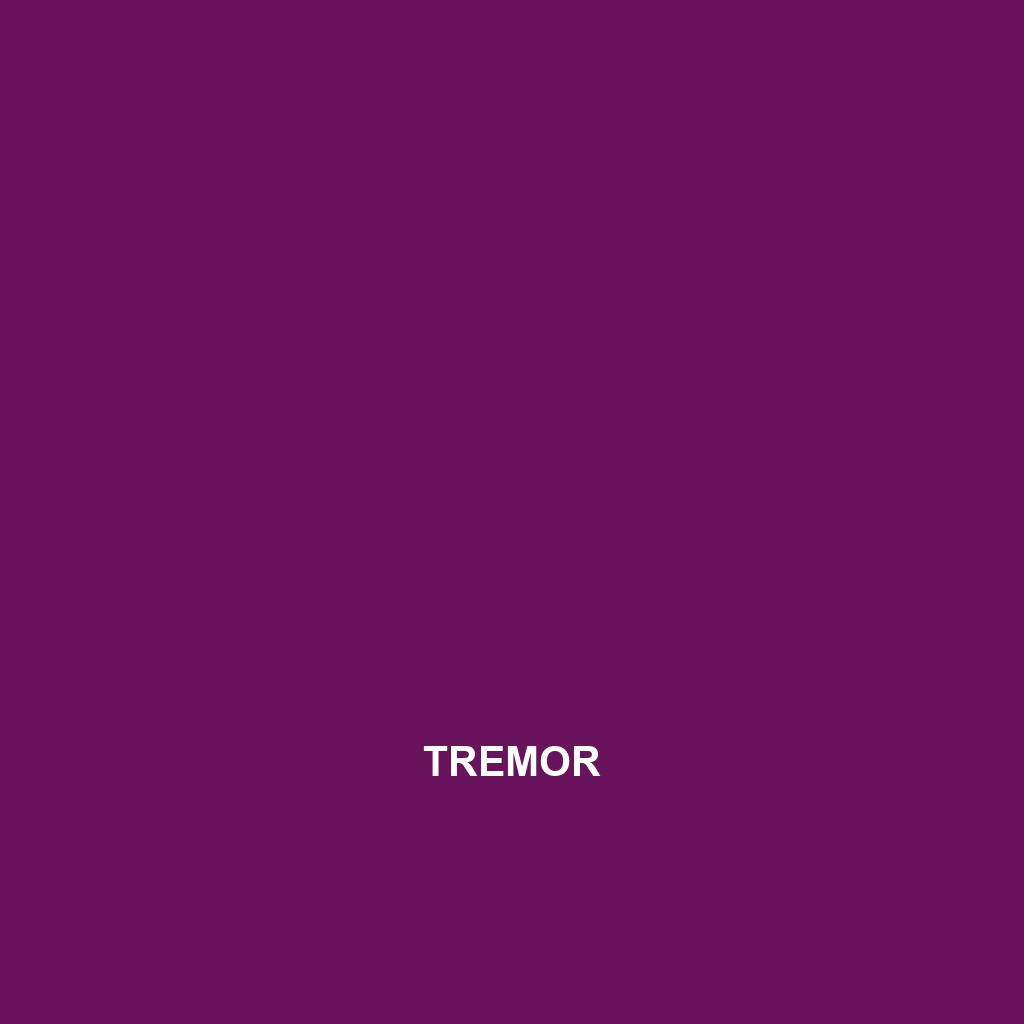Tremor:
Definition and Description of Tremor:
Tremor is defined as an involuntary, rhythmic muscle contraction that causes shaking movements in one or more parts of the body. This condition can affect various areas, including the hands, arms, head, and even voice. Medical professionals categorize tremors into different types based on their cause, severity, and a specific pattern of movement. The most common types include resting tremors, action tremors, and postural tremors. Each type has unique characteristics and may indicate underlying medical conditions, making accurate diagnosis crucial.
Causes of Tremor:
Tremors can result from numerous causes, including neurological disorders like Parkinson’s disease, essential tremor, and multiple sclerosis. External factors such as anxiety, fatigue, and the consumption of stimulants like caffeine can exacerbate tremors. Additionally, certain medications, alcohol withdrawal, and genetic predisposition may also contribute to the occurrence of tremors, making it crucial to evaluate the patient’s medical history and lifestyle.
Associated Symptoms of Tremor:
Alongside the shaking movements characteristic of tremors, individuals may experience other associated symptoms such as muscle stiffness, balance issues, fatigue, and difficulty in performing routine tasks such as writing or holding objects. Some patients may also report emotional effects, including anxiety or depression, which can significantly impact their quality of life.
Diagnosis of Tremor:
Diagnosis of tremor typically involves a thorough medical examination, including a detailed patient history and neurological assessment. Healthcare professionals may conduct tests such as blood work, MRI scans, or electromyography (EMG) to rule out other potential causes or underlying conditions. Understanding the tremor’s specific characteristics is key to determining the appropriate diagnosis and subsequent treatment options.
Risk Factors for Tremor:
Various risk factors can increase the likelihood of developing tremors. Age is a significant factor, as the condition is more prevalent in older adults. Lifestyle factors, including high caffeine consumption, alcohol use, and strenuous physical activities, can also contribute. Lastly, individuals with a family history of neurological disorders may face increased susceptibility to tremor disorders.
Complications of Tremor:
If left untreated, tremors can lead to several complications, including difficulty in performing everyday tasks and increased dependence on others for assistance. Severe tremors may impact mobility, lead to falls, and contribute to social withdrawal, resulting in isolation. Chronic tremors can also exacerbate mental health issues, including anxiety and depression, creating a cycle of symptoms that can be challenging to break.
Treatment Options for Tremor:
Treatment for tremors depends on the underlying cause and may include medications such as beta-blockers or anticonvulsants to help manage symptoms. Occupational and physical therapy can also be beneficial in improving coordination and adapting to daily activities. In some cases, surgical interventions like deep brain stimulation may be recommended. Additionally, lifestyle modifications, such as reducing caffeine intake and managing stress, might be helpful.
When to See a Doctor for Tremor:
Individuals should seek medical attention if they experience new or worsening tremors that interfere significantly with daily activities. Additional red flags include tremors that develop suddenly, tremors that are accompanied by other concerning symptoms such as stiffness or changes in speech, or if the individual is unsure about the cause of their tremors.
Prevention of Tremor:
While not all tremors can be prevented, certain strategies may help reduce their onset or severity. Maintaining a balanced diet, limiting caffeine and alcohol intake, engaging in regular physical activity, and managing stress through relaxation techniques can be beneficial in minimizing tremor symptoms. Moreover, regular check-ups with healthcare professionals can assist in early identification and management of risks.
Statistics and Prevalence of Tremor:
Tremors are a prevalent condition, affecting millions globally. According to studies, essential tremor is estimated to impact approximately 4% of the population, while Parkinson’s disease tremors affect around 60-70% of patients diagnosed with the disorder. The prevalence of tremors tends to increase with age, making them a significant public health concern.
Personal Stories or Case Studies about Tremor:
Personal accounts from individuals living with tremors often highlight the emotional and practical challenges of the condition. Case studies show how people have learned to adapt to their symptoms through therapy, support groups, and family involvement. Such testimonials emphasize the importance of finding community support and practical coping strategies to enhance their quality of life.
Myths and Misconceptions about Tremor:
There are several myths surrounding tremor disorders, one of which is that tremors only affect the elderly. This misconception overlooks the fact that tremors can occur in younger individuals as well, often due to various medical conditions or lifestyle factors. Another common myth is that all tremors indicate a serious medical issue; in reality, many cases of tremor, particularly essential tremors, can be managed effectively without significantly impacting life expectancy.
Support and Resources for Tremor:
Finding support is crucial for individuals experiencing tremors. Various organizations offer resources, support groups, and educational materials that can benefit those affected. For more information, visit this support page for additional resources and help.
Conclusion about Tremor:
In summary, tremors are a common, yet complex condition that can significantly impact an individual’s daily life. Understanding the causes, symptoms, and potential treatment options is essential for managing this condition effectively. If you or someone you know is dealing with tremors, seeking medical advice is critical for early intervention and support. Stay informed, and do not hesitate to reach out for assistance.
